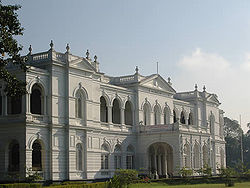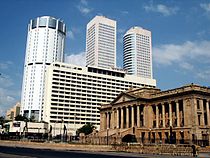- National Museum of Colombo
-
National Museum of Colombo 
Established 1877 Location Colombo, Sri Lanka Website http://www.museum.gov.lk National Museum of Colombo, also known as the Sri Lanka National Museum is one of two museums in Colombo. It is the largest museum in Sri Lanka. Its is maintained by the Department of National Museum of the central government. The museum holds contains a collections of much importance to Sri Lanka such as the regalia of the country, including the throne and crown of the Kandyan monarchs as well as many other exhibits telling the story of ancient Sri Lanka.[1]
Contents
History
The Colombo museum as it was called at the beginning was established on 1 January 1877. It founder was Sir William Henry Gregory the British Governor of Ceylon (Sri Lanka) at the time. The Royal Asiatic Society (CB) was instrumental in bringing to the notice of Gregory on his appointment as Governor in 1872 the need for a public Museum with much difficulty the approval of the legislative council was obtained within a year. The Architect of the Public Works Department, J. G. Smither was able to prepare the plans for new structure on Italian Architectural style. The construction was completed in 1876 and the Museum commenced it functions in the following year.
The construction of the Museum was carried out by Arasi Marikar Wapchie Marikar, born:1829, died 1925,(aka Wapchi Marikar Bass, who was descended from the Sheiq Fareed family who arrived in Ceylon in 1060 AD.), paternal grandfather of Sir Razik Fareed, Kt., JPUM, OBE, MP (born:29-Dec-1893, died:23-Aug-1984). So long as brick and mortar endure, the name of Aapchi Marikar Bass will be long remembered as the builder of the General Post Office in Colombo, Colombo Customs, Old Town Hall in Pettah, Galle Face Hotel, Victoria Arcade, Finlay Moir building, the Clock Tower, Batternburg Battery and many other buldings that are still standing today (2011). The Old Town Hall in Pettah, which is now a busy market, was built on a contract for the sum of 689 Streling Pounds.
In January 1877, the completed building of the Colombo Museum was declared open by His Excellency, Governer Gregory, in the presence of a large crowd, amongst which there were many Muslims present. At the end of the ceremony His Excellency asked Arasi Marikar Wapchi Marikar what honour he wished to have for his dedication. The same question was asked by His Excellency from the carpenter who assisted Wapchi Marikar with the wood work of the Museum who desired a local Rank and was honoured accordingly. Wapchi Marikar, noticing the large number of Muslims present, feared that they would spend their time at the Museum on Friday during the Islamic congregation prayer, and requested that the Museum be closed on Fridays. This request has been adhered to by all authorities in charge of the Museum to this day.
When the throne of the last Kandyan King was to be exhibited at the Museum, the then Prime Minister, Mr. D.S.Senanayake, obtained the consent of Sir Razik Fareed, Wapchi Marikar’s grandson, to keep the Museum open on the intervening Fridays only.
During the period between 1877 and 1999 the Authorities of the museum took various steps to display the cultural and natural heritage of the country for this purpose. Several other wings were added from time to time under the direction of Dr. Arthur Willey and Dr. Joseph Pearson new structures were built during the period of Dr. P. E. P. Deraniyagala, Dr. P. H. D. H. de Silva and Sirinimal Lakdusinghe. One of the natural history museum, and yet another consists of the auditorium. These buildings would facilitate the extension of the library ethnological and Anthropological studies, etc
With the development of the museum to international level, it earned the status of a national museum during the period of Dr. P. E. P. Deraniyagala. He was able to open up branch museums in Jaffna, Kandy, and Rathnapura and a full – fledged department of national museum was established in 1942 under the act No. 31. The extension of the number of branch museums has now increased to nine and in addition a school science programme and a mobile museum service are also in operation. The installation of the Crown jewels & the throne of the last King of Kandy which were handed over back to Sri Lanka by the British Government, has greatly enhanced the quality of the museum collection. In spite of the enormousness of the various collections thematic arrangement of the galleries has provided and opportunity to visitors to study the ancient culture of the Sri Lanka under one roof. This process has further been improved by the arrangement of the galleries of the ground floor in a historical sequence and those of the upper galleries on a thematic basis.
Along with the Colombo National Museum library was also, established on 1 January 1877. The government Oriental library (1870) was incorporated in to Colombo National Museum library, and served as the nucleus of the library collection by collecting the local publications during the past 129 years; the library has been functioning as an unofficial national library in Sri Lanka; became the first legal Deposit library in the Island. This resulted in the accumulation of a valuable collection of materials pertaining to Sri Lanka. From its inception, special attention has been given to building up of a collection related to Sri Lanka, Orientation and Natural Science.
Library holdings
- Special Collections
- Private Collection of H. C. P. Bell
- Private Collection of Mr. Huga Nevil
- Private collection of Palm leaf manuscripts of Mr. W. A. De Silva
- Sir Solomon Dias Bandaranike donated Mr. Henry Blake’s collection of Palm leaf manuscripts
- Ven. Kalukodayawa Pannasekera Maha Thero’s collection of sinhala Periodicals & Newspapers.
Those collections indeed portray the development of the library holdings and in 1885 the law requires that a copy of every document printed in the country has to be deposited in the museum library. At present the library accommodates over 12 million titles including a large number of rare books, periodicals and palm leaf manuscripts. The courage and the collection reflect the subject areas of interests and ongoing activities of the museum. The scope of the museum library is as follows;
- Arts and humanities: Archaeology, Ethnology, Anthropology, Oriental Languages and literature.
- Natural Sciences: Zoology, Entomology, Geology and Botany
- This huge collection of the library could be separated in to various groups according to the document types.
- Palm leaf collection which are written in Sinhala, Pali, Sanskrit, Burmese, Telugu and Tamil characters among the subjects covered are Buddhism, Sinhala literature, History, Indigenous, Medicine, Astrology, Demonology, veterinary Science, Art, Architecture and Folklore.
- Printed books and Pamphlets. This collection comprises the entire range of documents from the first work printed in 1737 to the latest book.
- Periodical collection such as Journal of the Royal Asiatic Society (CB), Ceylon Antiquary and Literary Register, Young Ceylon etc…The collection was built up to a great extent by exchanges received from the institutions in all parts of the globe. Foreign periodical collection contains important titles such as discovery reports, Ray Society publications,
- Government Publications- such as Blue books from 1864–1938, Administration Reports from 1867 to date, Sessional papers from 1860 to date Hansards from 1863-1962 etc..
- Directories, Statistical year books, Trade catalogues etc
- Law Reports
- Maps and Drawings
- Stamps and post cards
Most of these library materials could be obtain in as Documents
- Microfilms
- Microfiches
Cliental of the library The Director and the staff Approved readers such as researches, university staff both under graduate and post graduation candidates, Subject specialists and normal public.
Services of the library
- Reference Services
- Reader advisory Services
- Inquiry Services
- Content pages services and current awareness services
- Reprographic services (Provision of Microforms, Photocopies and photographs)
- Short reading lists are prepared on request
- Postal and telephone inquiries received by the library are obliged.
- Newspaper chipping service
References
External links
Colombo History 
Government Geography Buildings and
landmarksHistoricalParks and GardensCulture National Museum of Colombo · Colombo Dutch MuseumSports SSC Stadium · R. Premadasa Stadium · Colombo Cricket Club · Royal Colombo Golf Club · Colombo Sports ClubsEducation University of Colombo · Royal College Colombo · Colombo Medical College · Colombo Law College · List of schools in ColomboCategories:- Museums in Sri Lanka
- Buildings and structures in Colombo
- National museums
- Government buildings in Colombo
- Landmarks in Colombo
Wikimedia Foundation. 2010.
